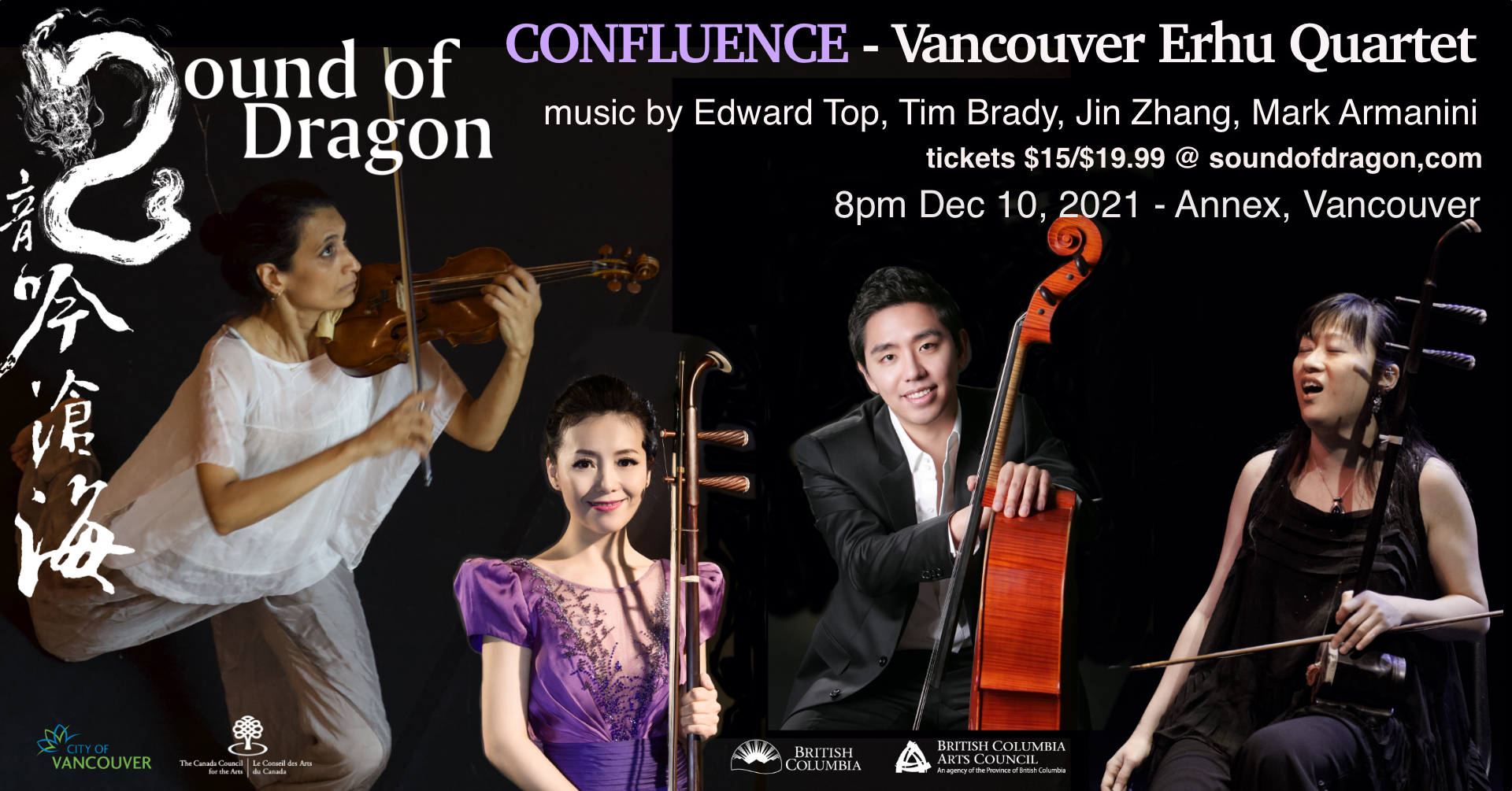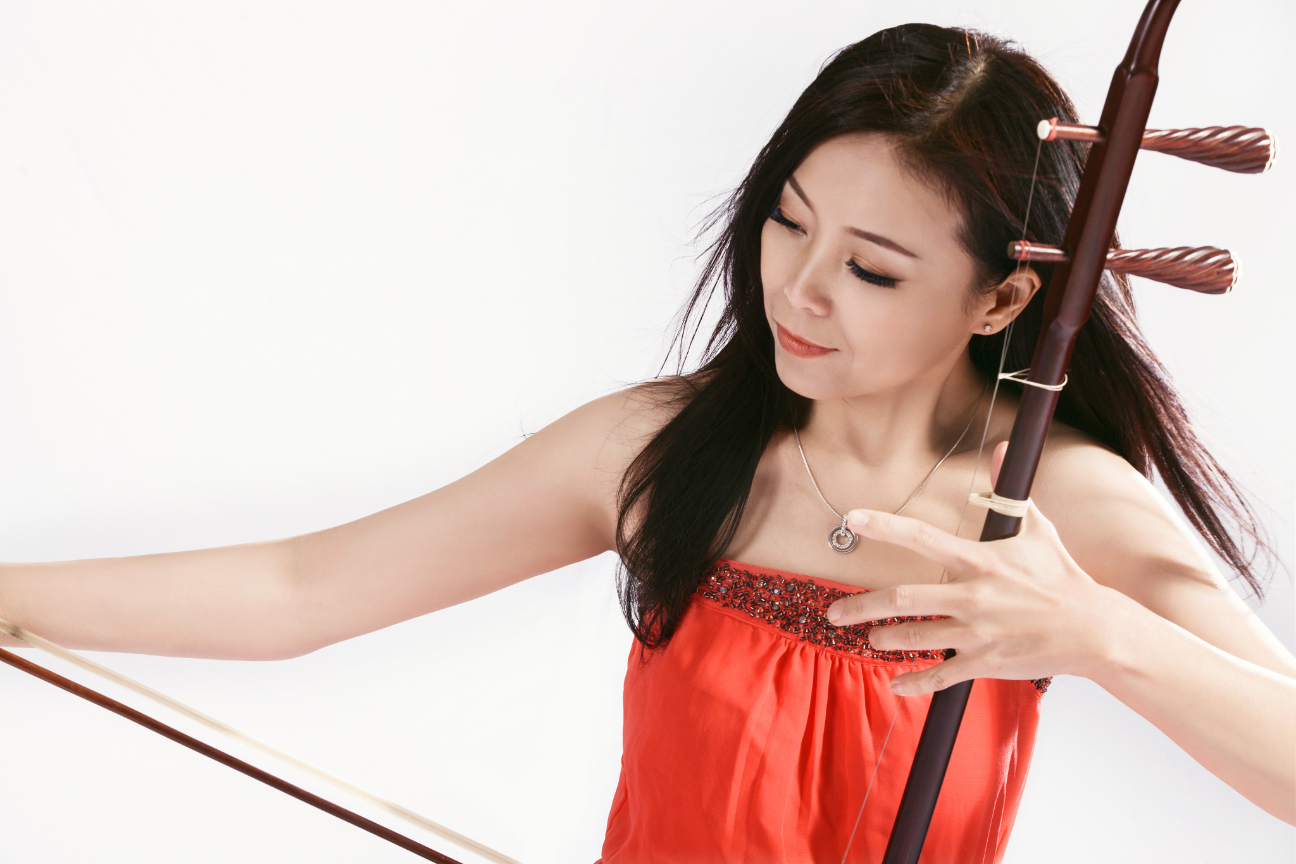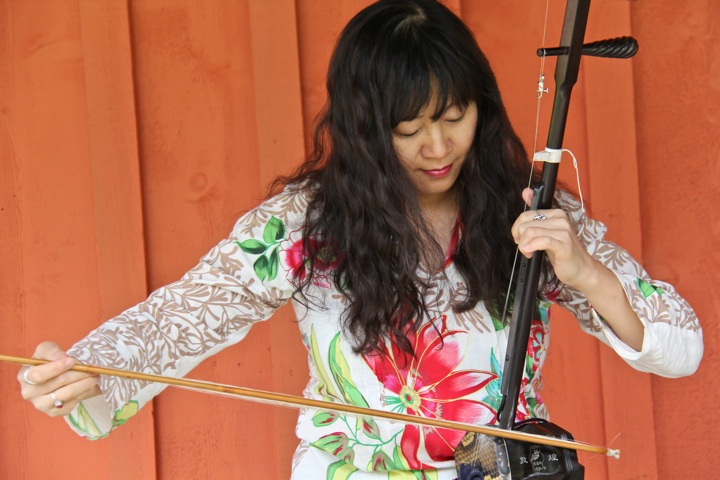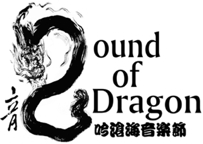CONFLUENCE 【匯流】音樂會
Vancouver Erhu Quartet 溫哥華二胡四重奏
8pm Dec 10, 2021 at the Orpheum Annex,
823 Seymour Street, Vancouver – live audience
TICKETS $19.99 regular, $15 students/seniors/children
available at https://confluence.bpt.me/

Program:
Night Song VII – Mark Armanini
This gentle sounding work begins as a lullaby and gathers momentum throughout. The intense lyricism is personified through the erhu, matched by the viola and cello. The viola and cello provide the chordal outlines and contrapuntal background in which the two erhus engage in conversation with. This may suggest a western compositional perspective, but the piece is easily imagined as a Song Dynasty scroll or landscape drawing or a nature poem. The flowing triplet rhythm is unusual in Chinese traditional music, but it is well suited to the vocal quality of the erhu and the harmonic folk-like capabilities of the viola and cello. The rhythmic activity becomes a powerful force in the work, quickening to a grand climax, with the erhus supported and carried along by the torrent of notes and power of the viola and cello.
This Erhu Quartet (2021) – Tim Brady, world premiere
Commissioned by the Vancouver Erhu Quartet with funding from the Canada Council for the Arts
This 10-minute worked started out with a simple idea: that is, exploring slow, static harmonies with the ensemble, combined with singing, idiomatic melodies for the two erhus. But about half way through the composition process, a strong rhythmic idea in 5/16 showed up unannounced and changed the direction of the work. The addition of this rhythmic music created a work that has become somewhat a study in contrasts, with a three-part form. The initial slow harmonies and melodies eventually give way to the new, more rhythmic music. The work ends with a return to more static harmonic ideas, but with a greatly expanded sense of register and orchestration.
Flicking Candles 燭映搖紅 (1932) – Tianhua Liu – Jun Rong erhu solo
One of the ten famous erhu solo works by Tianhua Liu, an important composer in the development of contemporary Chinese music.
Improvisation (Dec 10, 2021) – Parmela Attariwala viola & Lan Tung erhu/vocal
Instant composition created on stage by the two improvisers for tonight’s audience. Parmela and Lan have known each other as improvisers for many years. But this is their first time improvising as a duet on stage. It is made possible because of Parmela’s recent move from Toronto to Vancouver.
Confluence (2021) – Edward Top, world premiere
This piece brings together the prolation canon of Renaissance technique with the heterophony of Chinese music. I first became familiar with Asian music and instruments during my time as a violinist in the Bangkok Symphony Orchestra, and when students at the Bangkok Symphony Music School showed me the saw duang, the Thai version of the erhu. I noticed in traditional Thai and Chinese music how each musician plays the same melodic lines with different ornamentation to compliment one another, creating a heterophonic texture. My recent works have combined this approach with Dutch minimalist microcanon technique, where a motive in unison is played deliberately out-of sync by a (dotted) quarter or eighth note, producing a delay-effect.
In Confluence, I have taken this technique into a new direction with the prolation canon. Similar to the microcanon, the instruments play the same motive canonically, entering one after another. However, in the prolation canon, they also play at different speeds. Each time the motive starts at different instances in each voice, polyphony is created as each version against one another sounding out-of synch. Gradually the instruments line up into short moments of unison and then drift apart again. Ornamentation idiomatic to both Chinese and Western string instruments is used to create varied surface textures. All four instruments play in the same register, bringing the viola, and especially the cello to their highest register. With special attention to adjusting the tone, articulation, and vibrato in order to balance between the two erhus with the Western strings, the result is a sophisticated ensemble. A word of gratitude to Ms. Lan Tung, who, with the Vancouver Erhy Quartet commissioned the work.
Teasing Golden Snake (2020) – Jin Zhang, world premiere
This 3-movement piece was inspired by a well-known Chinese traditional folk tune “Crazy Dance of Golden Snakes”. The composer utilizes a variety of conventional and extended techniques of the string instruments, focusing on the ones that best represent the characteristics of the erhu, to express the nature of the snakes: fluidity, suspense, and swift movements. The piece vividly depicts a dynamic scene of imaginary snake dance and the magics from an entertaining snake charmer.
Created during the pandemic year, the Vancouver Erhu Quartet explores the sonic possibilities combining the erhu with western strings. The quartet consists of Vancouver erhu players Lan Tung and Jun Rong, violinist/violist Parmela Attariwala, and cellist Sungyong Lim. They bring together expertise in various genres, from traditional, contemporary, classical, avant-garde, to world/cross-cultural music. This concert is the quartet’s first performance with in-person audience, and it will perform music by Canadian composers Edward Top, Jin Zhang, Mark Armanini, and Tim Brady.
The program includes three world premieres: Traditional music in Asia often has unison melodies played on a number of instruments, but each may be with different ornamentation to complement one another. Edward Top’s “Confluence” combines this approach with Dutch minimalist “microcanon” technique, where a motive in unison is played deliberately slightly out-of sync to create a delay effect. Tim Brady’s music has two contrasting moods: slow static harmonies and fast polyrhythms. Being an erhu player himself, Jin Zhang composes “Teasing Golden Snake” with idiomatic erhu techniques to vividly depict a dynamic scene of snake dance and the magic of an entertaining snake charmer. In addition, Mark Armanini’s new arrangement of his romantic “Night Song” brings out the singing quality of the four instruments that weave densely together.
Known for its expressive sounds, the erhu (Chinese violin) is a very versatile instrument that has been used in various musical genres around the world. An instrument of ancient roots, the modern erhu has undergone significant development in its construction/workmanship, techniques, and repertoire. Some variations in the erhu family include gaohu (tuned a 5th higher), zhonghu (tuned a 5th lower), and lower tone erhu. An erhu quartet is a new performance format starting to emerge in Asia in recent years. There are currently only a handful of erhu quartets in the world, and Vancouver Erhu Quartet is the first one in Canada.
融合東西方弓弦樂器,新成立的溫哥華二胡四重奏,以二胡與提琴的組合,將於12月10日舉行首場音樂會。團員包括來自台灣的董籃及來自北京的戎峻共同擔任二胡演奏,印度裔的帕米拉.阿特瓦拉 (Parmela Attariwala) 擔任中提琴手,以及來自韓國的林成容 (Sungyong Lim) 擔任大提琴手。他們各自專研的領域,涵蓋傳統音樂、古典音樂、現代音樂、即興演奏、世界音樂、到跨界表演藝術,在一起合作各展所長、互助互補,並為樂團帶來多元的活力。
音樂會將首演三首委託創作的樂曲:張進的「逗金蛇」(Teasing Golden Snake)靈感來自傳統曲調「金蛇狂舞」,描繪金蛇與玩蛇藝人的生動形態。Edward Top的「匯流」(Confluence)借鑑亞洲傳統音樂常見的齊奏,配合荷蘭現代樂手法「微卡農」(microcanon),每個樂器雖然演奏同一旋律,但時間上稍微錯開,用刻意營造出的不整齊,形成複雜的節奏。Tim Brady的「二胡四重奏」(This Erhu Quartet) 以緩慢的和聲進行,對比快速的五拍子。Mark Armanini改編自己的作品「夜曲」(Night Song),如歌的旋律,在四個樂器之間轉換交織。
做為極具表現力的樂器,二胡在世界各地被廣泛地使用於不同風格的音樂。這個擁有千年歷史的古老樂器,在近代不管是製作工藝、演奏技巧、曲目擴充方面,都有大量的提升,並且根據樂曲需要,以高胡、中胡、低音二胡等不同音域的胡琴彼此配合使用,以至於近年終於有了胡琴樂團在亞洲誕生。溫哥華二胡四重奏是加拿大第一個以二胡為主的弓弦樂室內樂團,以中西合璧的方式,透過胡琴與提琴的對話,探索新的音響。
票價 $19.99,老人/學生/兒童 $15,購票網址 at https://confluence.bpt.me/
Erhu (Chinese violin) 二胡
Originated in Central Asia and introduced to China more than one thousand years ago, the erhu 二胡 belongs to the large family of stick fiddles that are found in many countries. Xiqin 奚琴, believed to be the precursor of the erhu, was the first bowed instrument mentioned in Chinese literature in Tang Dynasty (618-907 A.D.). Xiqin was also called huqin 胡琴. The erhu is usually made of ebony, sandalwood or rosewood, with a snakeskin resonator. The folk versions vary in the shapes and materials. The bow is made of bamboo stick and horse hair. Since 1960s, the strings are made of steel, learning from the violin and replacing the silk strings from the ancient time. A popular instrument in solo and ensemble music, erhu’s expressive sound resembles the human voice. Its traditional repertoire is deeply rooted in the vocal and opera traditions.
hu = people lived in the north and west of China;
qin = musical instrument
huqin = musical instrument of the hu people, referring to the origin of the instrument
er = two, stating that the instrument has two strings




Jun Rong 戎峻 – erhu
Jun has appeared at many concerts, festivals, recordings, and CBC radio broadcast. She is a member of Vancouver Inter-Cultural Orchestra and Silk Road Music Ensemble. She performs in a duo with harpist Lani Krantz. Jun was a guest soloist with the Victoria Symphony, Calgary Symphony, and Vancouver Symphony Orchestra, as well as the internationally renowned Vega String Quartet. Jun has released a number of CDs, including one featuring the master works of Tian-hua Liu, the most important Chinese composer for erhu music in the 20th century. Jun teaches the erhu at the Capilano University. After graduating from the China Music Academy in Beijing, Jun joined the China Opera & Dance Orchestra before making Vancouver her new home.
Lan Tung 董籃 – erhu
Artistic director of Orchid Ensemble, Sound of Dragon Society, and Proliferasian, Lan has appeared as a soloist/composer with Orchestre Metropolitain (Montreal), Vancouver Symphony Orchestra, Symphony Nova Scotia, Turning Point Ensemble, Upstream Ensemble (Halifax), Atlas Ensemble (Amsterdam & Helsinki), and Little Giant Chinese Chamber Orchestra (Taipei). As a producer/performer/composer, Lan has collaborated with musicians, dancers, and media artists from different cultures. After studying at Taiwan’s Chinese Cultural University, Lan has traveled around the world to study Hindustani music with Kala Ramnath, improvisation with Mary Oliver, graphic score with Barry Guy, Uyghur music with Abdukerim Osman, and Mongolian Horsehead fiddle with Bayar. At the Vancouver Creative Music Institute (2007-2009), she studied/improvised with Han Bennink (Holland), Barry Guy, Evan Parker, John Butcher (UK), Francois Houle, Paul Plimley…etc. Lan has won an International Independent Music Awards and multiple nominations by the JUNO Awards, Canadian Independent Music Awards, Canadian Folk Music Awards, and Western Canadian Music Awards.
Parmela Attariwala – viola
Violinist Parmela Attariwala interweaves life as a performer-creator, academic, and music educator. Parmela trained formally in violin performance at Indiana University and in Bern, Switzerland, and studied ethnomusicology at the School of Oriental and African Studies (UK) and the University of Toronto (Ph.D.). Her creative work explores the liminal space between musical genres, artistic disciplines, and identities; often using improvisation as a point of departure. She has recorded three Attar Project albums featuring works for violin and tabla. Attariwala has also collaborated extensively with choreographers (bharata-natyam, butoh and contact) as composer and movement artist. Parmela’s recent creative output includes multi-authored comprovisations, sonic memorials based on end-of-life bhakti poetry, and collaborations with performance artists Peter Morin and Ayumi Goto. She is co-composer (with Ian Cusson) of the opera-in-progress Namwayut (Calgary Opera) and has contributed to the Esker Foundation’s permanent collection in response to works by visual artists Jeffrey Gibson and Nep Sidhu. Parmela’s ongoing research and advocacy focus on equity, identity and ethics in Canadian music and education.
Sungyong Lim 林成容 – cello
Sungyong graduated with honors from the renowned Yewon School and the Seoul School of the Arts before entering the Korea National University of Arts. Later he earned a VorDiplom, a Diplom (same as Bachelor, Master Degree), a konzertexamen’s (The “Konzertexmen” is highest degree available at music university in Germany) in cello performance from the Detmold Musik Hochschule. Sungyong graduated at the top of his class, with a comprehensive performance repertoire and with considerable teaching experience. Sungyong is a member of the Borealis String Quartet, who received the honor of “Distinguished Fellow of BC” for their applauded lectures presented there as visiting scholars at Green College@ UBC. Sungyong’s passion for teaching and education is of paramount importance. In Vancouver, he has coached countless students in schools, given masterclasses, and worked with the school orchestras. On tour, he has taught and been in residence at many universities and given master classes worldwide. Sungyong plays on a 1843 Enrico Ceruti made in Cremona.




